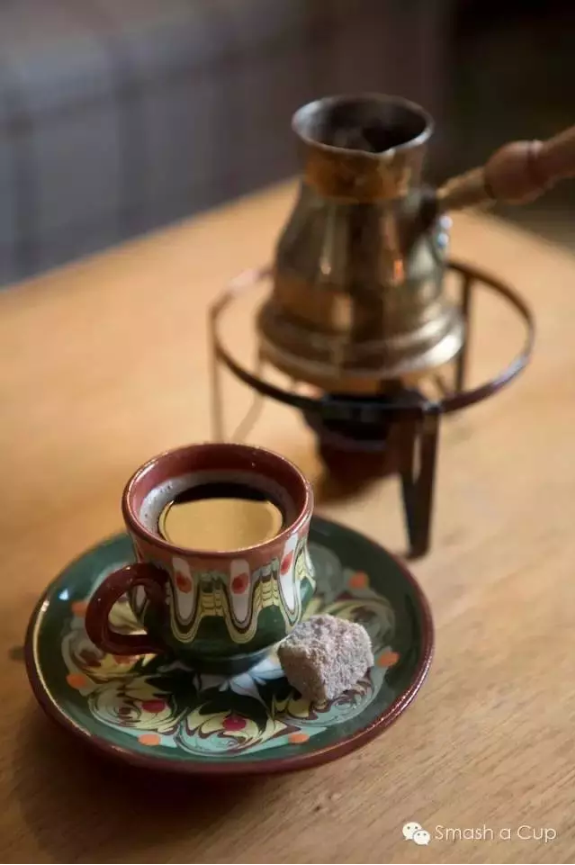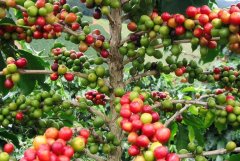Turkish coffee, return to "traditional and sensual" coffee flavor of cinnamon and cardamom
I am a person who is not very smart in technology and numbers. What I am most afraid of is that someone asks me horrible questions such as the model of the coffee machine and the altitude of the beans.
I like to get in touch with the world in an emotional way, including coffee, so what attracts me is objects that look and feel both beautiful and textured, and ways of approaching knowledge also like stories rather than data.
As a result, I naturally began to like Turkish coffee and began to collect various versions of Turkish coffee utensils, reveling in the texture of the bronzes and legends.

The word Coffee, as a drink, is a variant of the Turkish language kahveh, and kahveh itself comes from the Arabic word kahwa. As a plant, it originated from the Arabic bunchum, which evolved from the African language bun. Therefore, from the development of these words, we can reverse the development path of coffee.
Coffee originated in northeast Africa, and it has been full of legends about how it was discovered: dancing goats, the medicine of the Trojan beauty Helen, the gift of the Archangel Gabriel, and Sufi ascetics. But I prefer the Arab version. Legend has it that Mufti (the Islamic leader) of Aden stumbled upon the berries in the bushes by the side of the road to rejuvenate himself and the sedan chair man from the exhaustion of illness, so he tried to boil the berries in water. when he drank the boiled slurry, he was able to stay awake all night without feeling uncomfortable. So he took the berries back to the temple and ordered the monks to drink them every night. As a result, the monks became more alert and more willing to attend evening prayers. At first, coffee was only used for night prayers, and with the grand form of carols, drinking coffee became a matter of edifying the body and mind. Soon, people who wanted coffee told each other that they could drink this drink as a reward as long as they went to the temple to pray, so there were more and more believers. After that, Arab religious groups and towns began to follow the example of Aden and spread to the holy city of Mecca at the end of the 15th century. Because Muslims banned alcohol, coffee was nicknamed "Arab wine" and gradually began to carry the social needs of ordinary people outside religion. After a while, people began to drink coffee at home and in certain public places. Under the guise of drinking coffee, people chatted, listened to music, danced, and played chess. Yes, the coffee shop showed up.
With the expansion of the Ottoman Empire and the conquest of Arab Muslims, coffee was introduced into Turkey. The first two cafes in Constantinople were founded in 1554 by two Syrian industrialists. Coffee is accepted by people in a new region in two ways: on the one hand, as a refreshing and healthy drug, and on the other hand, as a fresh and elegant way of socializing, it has been so for hundreds of years until now. Just as no normal person will not be choked by smoking for the first time, no one with a normal sense of taste is born to drink this bitter water, including myself. It is believed that everyone held their nose and swallowed it when they drank black coffee for the first time, so it was the same in Turkey at that time. The two shrewd businessmen beautifully decorated the coffee shop, entertaining guests on neat recliners and elaborate carpets, initially as diligent scholars, court inspectors, professors or students looking for a decent job. They sit cross-legged or lean on cushions in a Turkish way, chatting, listening to stories or poetry readings, and sometimes some musicians shuttling through them. At that time, coffee was as hot as possible, as black as soot, and they believed that the drink helped digestion and made hands and feet agile. Of course, women were not allowed to go in and out of such public places at that time, so the owner of the coffee shop would hire beautiful young men to serve coffee and attract guests.
With the growing popularity of coffee, the demand for this black liquid is no longer just an accessory to elegant social occasions. Turkish people begin to really fall in love with coffee itself (at this stage, just like China now). People began to drink coffee at home, and in Constantinople, the amount of money that families spent on coffee was comparable to that spent by the French on wine. Turks believe that drinking coffee can cure all diseases, so no matter sooner or later, no matter how well-off the family is, there is no one who does not brew coffee on the stove all day, and it has become a ceremonial habit for guests to hand over a cup of coffee.

Add coffee powder, sugar and spices (cinnamon, cardamom, fennel, cocoa, etc.) to Ibrik, then add cold water and mix.

Then heat the pot over low heat, wait until the coffee begins to boil, quickly remove it from the fire, stir and then put back, the second boiling away again, without stirring, to the third boiling can be drunk.

When the Turkish coffee maker (Ibrik) is in use, it is necessary to break the rules of modern boutique coffee science on coffee and return to the most primitive way of making coffee. In fact, only Turkish coffee is what we usually call "brewing coffee", because in modern times, "extracted coffee is strictly forbidden to be heated by direct heat." When cooking, the amount of powder, water, a variety of sugar and spices, such as cinnamon, cardamom, fennel, can be boldly added and adjusted according to personal preferences. After boiling three times over low heat, pour evenly into each cup in turn. It is conceivable that coffee brewed in this way must have residue of coffee powder in the cup. But these crumbs may be another beauty of Turkish coffee. The so-called gypsy fortune teller is based on the pattern of residue left at the bottom of the cup after everyone has finished drinking the coffee.
To me, Turkish coffee is like an exit, allowing me to extricate myself from the modern "so-called boutique theory and technology" and return to the most traditional, sensual and charming era of coffee.
I like to sit outside the shop in a cloak, making Turkish coffee for students while telling stories against the strong wind in Beijing, imagining that we are a 16th-century Arab business trip, tethering camels, pitching tents, lighting bonfires, roasting and brewing coffee at the same time, regardless of grinding degree and gouache ratio, it is to steal and share all kinds of spices from the boss in everyone's camel bags.
You grab a handful of coffee beans, I grab a handful of cocoa beans, as well as his cinnamon and nutmeg, mash together into the pot, hookah and story begin to rise at the same time, floating in the man's headscarf, beard and laughter in the desert at night.
Author | Clark
Clark, Taurus barista. He left the animation and advertising industry at the age of 30 and began to devote himself to coffee. Two years later, with the idea of opening a small shop for people who really like coffee and quiet, Caf é Clark, a Japanese antique coffee shop, was founded in a remote corner of Beijing. Every year, I will set aside some time to go to various countries for coffee-related study exchanges, hoping to share the good coffee and interesting lifestyle with more friends in the store.

Important Notice :
前街咖啡 FrontStreet Coffee has moved to new addredd:
FrontStreet Coffee Address: 315,Donghua East Road,GuangZhou
Tel:020 38364473
- Prev

Don't say you know coffee, do you know these 18 things about coffee?
Coffee is one of the three biggest drinks in the world and is very popular. But people don't know so much about it. To this end, the author wrote 18 honey words to add flavor to your cup of coffee in the morning. Read further and you will see information about the origin of the coffee, the amount of water needed to harvest a pound, and some information about the Kopi Luwak. 1. Rumor has it that the shepherd found the best coffee.
- Next

Nicaragua and Lemon Manor Nicaragua is located in central Central America, which is the largest in China and the United States.
Nicaragua, located in the middle of Central America, is the largest country in China and the United States, bordering Honduras in the north, Costa Rica in the south, the Caribbean Sea in the east and the Pacific Ocean in the west. The eastern part is the coastal plain, the high temperature and rainy climate belongs to the tropical maritime climate, and the western part is the coastal lowland with more active volcanoes. The north-central part is a highland, with an average annual temperature of 18 ℃ and an annual precipitation of 1500-2500mm.
Related
- Does Rose Summer choose Blue, Green or Red? Detailed explanation of Rose Summer Coffee plots and Classification in Panamanian Jade Manor
- What is the difference between the origin, producing area, processing plant, cooperative and manor of coffee beans?
- How fine does the espresso powder fit? how to grind the espresso?
- Sca coffee roasting degree color card coffee roasting degree 8 roasting color values what do you mean?
- The practice of lattes: how to make lattes at home
- Introduction to Indonesian Fine Coffee beans-- Java Coffee producing area of Indonesian Arabica Coffee
- How much will the flavor of light and medium roasted rose summer be expressed? What baking level is rose summer suitable for?
- Introduction to the characteristics of washing, sun-drying or wet-planing coffee commonly used in Mantenin, Indonesia
- Price characteristics of Arabica Coffee Bean Starbucks introduction to Manning Coffee Bean Taste producing area Variety Manor
- What is the authentic Yega flavor? What are the flavor characteristics of the really excellent Yejasuffi coffee beans?

